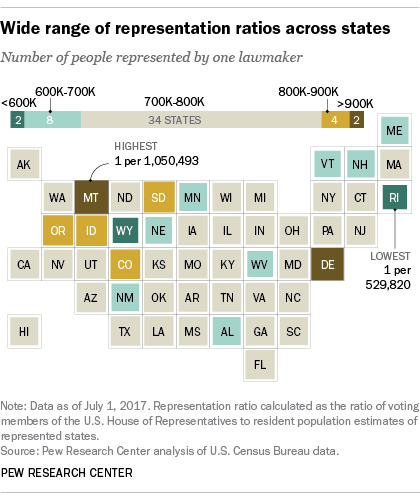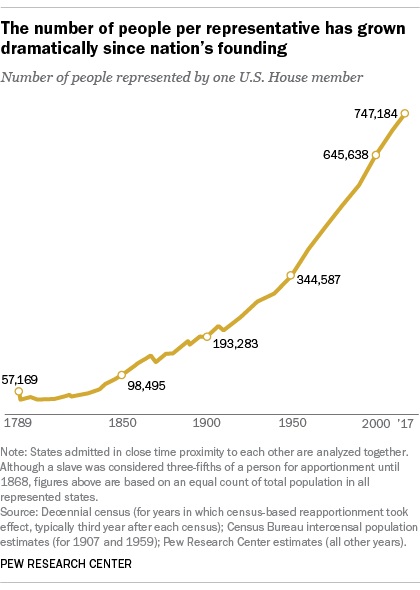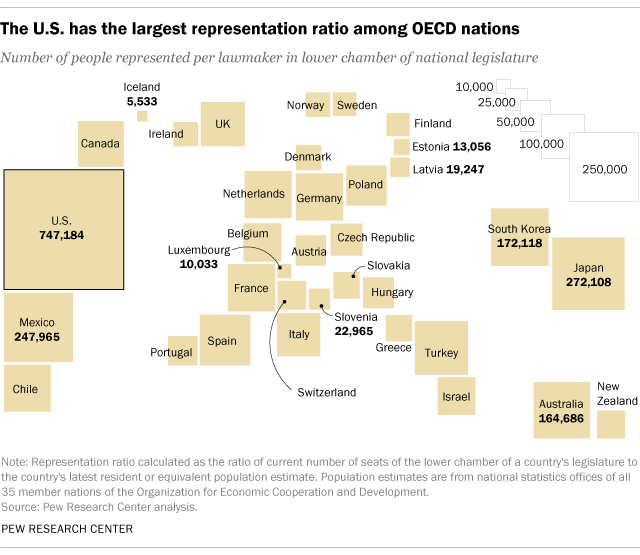How Many House of Representatives in Each State
The U.Southward. House of Representatives has one voting fellow member for every 747,000 or so Americans. That's past far the highest population-to-representative ratio among a peer grouping of industrialized democracies, and the highest information technology's been in U.S. history. And with the size of the House capped past law and the land'due south population continually growing, the representation ratio likely will merely get bigger.
In the century-plus since the number of Business firm seats offset reached its current total of 435 (excluding nonvoting delegates), the representation ratio has more than tripled – from i representative for every 209,447 people in 1910 to one for every 747,184 as of last year.
 That ratio, mind you, is for the nation as a whole. The ratios for individual states vary considerably, mainly because of the Business firm's stock-still size and the Constitution's requirement that each state, no matter its population, have at least one representative. Currently, Montana's ane,050,493 people have merely 1 Firm member; Rhode Island has slightly more people (1,059,639), but that's enough to give it ii representatives – one for every 529,820 Rhode Islanders.
That ratio, mind you, is for the nation as a whole. The ratios for individual states vary considerably, mainly because of the Business firm's stock-still size and the Constitution's requirement that each state, no matter its population, have at least one representative. Currently, Montana's ane,050,493 people have merely 1 Firm member; Rhode Island has slightly more people (1,059,639), but that's enough to give it ii representatives – one for every 529,820 Rhode Islanders.
The U.Due south. findings in this post are based on Pew Research Centre analyses of House membership changes since 1789 and historical population data (bodily when available, estimated when not). They exclude territories, the District of Columbia and other U.Due south. possessions that don't accept voting representation in the House. The analysis was complicated somewhat by the fact that new states ofttimes were admitted after a decennial demography merely before the apportionment law based on that census took effect (usually about 3 years afterwards). In such cases, the new states were analyzed as if they had been states at the time of the census.
How the Business firm reached 435
The first Congress (1789-91) had 65 House members, the number provided for in the Constitution until the starting time demography could be held. Based on an estimated population for the xiii states of 3.seven million, there was one representative for every 57,169 people. (At the time, Kentucky was part of Virginia, Maine was office of Massachusetts, and Tennessee was part of North Carolina. Vermont governed itself equally an independent republic, despite territorial claims by New York.)
By the time the first apportionment bill took effect in March 1793, Vermont and Kentucky already had joined the Union; the 15 states had a total population of 3.89 million. Since the apportionment police force provided for 105 House members, there was one representative for every 37,081 people. (Co-ordinate to the Constitution at the fourth dimension, only three-fifths of the nation'southward 694,280 slaves were counted for apportionment purposes; using that method, the ratio was approximately i representative for every 34,436.)
For more than a century thereafter, every bit the U.Due south. population grew and new states were admitted, the House'southward membership grew too (except for ii short-lived contractions in the mid-1800s). The expansion generally was managed in such a way that, even as the representation ratio steadily rose, states seldom lost seats from one apportionment to the next.

That process ran aground in the 1920s. The 1920 census revealed a "major and standing shift" of the U.South. population from rural to urban areas; when the time came to reapportion the House, as a Demography Agency summary puts it, rural representatives "worked to derail the process, fearful of losing political power to the cities." In fact, the House wasn't reapportioned until later the 1930 census; the 1929 law authorizing that demography as well capped the size of the House at 435. And there it has remained, except for a brief period from 1959 to 1963 when the chamber temporarily added 2 members to represent the newly admitted states of Alaska and Hawaii.
In that location take been occasional proposals to add more seats to the House to reflect population growth. One is the then-called "Wyoming Rule," which would make the population of the smallest state (currently Wyoming) the basis for the representation ratio. Depending on which variant of that rule were adopted, the House would take had 545 to 547 members post-obit the 2010 demography.
However, a recent Pew Inquiry Heart survey found express public support for adding new House seats. Just 28% of Americans said the House should be expanded, versus 51% who said it should remain at 435 members. When historical context was added to the question, support for expansion rose a bit, to 34%, with the additional support coming mainly from Democrats.
How the U.South. compares globally
The House's hefty representation ratio makes the The states an outlier amongst its peers. Our enquiry finds that the U.Due south. ratio is the highest amidst the 35 nations in the Organisation for Economic Cooperation and Development, most of them highly developed, democratic states.
 We took the nigh recent population estimate for each OECD nation and divided information technology by the current number of seats in the lower chamber of each national legislature (or, in the instance of unicameral bodies, the single chamber). After the U.S., the two countries with the highest representation ratios are Japan (one lawmaker for every 272,108 Japanese) and Mexico (i for every 247,965 Mexicans). Republic of iceland had the lowest ratio: one member of the Althing for every 5,500 or so Icelanders.
We took the nigh recent population estimate for each OECD nation and divided information technology by the current number of seats in the lower chamber of each national legislature (or, in the instance of unicameral bodies, the single chamber). After the U.S., the two countries with the highest representation ratios are Japan (one lawmaker for every 272,108 Japanese) and Mexico (i for every 247,965 Mexicans). Republic of iceland had the lowest ratio: one member of the Althing for every 5,500 or so Icelanders.
While much of the cross-national disparity in representation ratios can be explained past the big population of the U.S. (with more 325 million people it'southward the largest land in the OECD), that'southward not the simply reason. 8 OECD countries accept larger lower chambers than the U.South. House, with Federal republic of germany'due south Bundestag topping the league table with 709 members. The British House of Commons has 650 MPs (Members of Parliament); Italia'southward Chamber of Deputies has 630 lawmakers.
Even if Congress decided to expand the size of the House, the large U.S. population puts some practical limits on how much the representation ratio could be lowered. If the House were to abound as large as the Bundestag, for case, the ratio would autumn but to ane representative per 458,428 people. In order to reduce the ratio to where it was after the 1930 census, the Business firm would need to take 1,156 members. (That would still be smaller than China's National People's Congress, the largest national legislature in the world with 2,980 members.)
thompsonwhencer2002.blogspot.com
Source: https://www.pewresearch.org/fact-tank/2018/05/31/u-s-population-keeps-growing-but-house-of-representatives-is-same-size-as-in-taft-era/
0 Response to "How Many House of Representatives in Each State"
Post a Comment